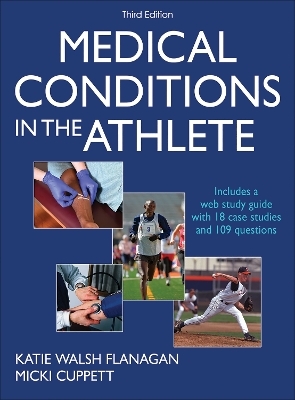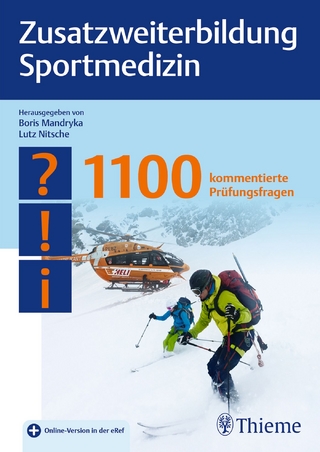
Medical Conditions in the Athlete
Human Kinetics (Verlag)
978-1-4925-3350-4 (ISBN)
Medical Conditions in the Athlete, Third Edition With Web Study Guide, equips health care providers with the information they need to develop a framework for decision making when working with injured and recovering athletes and active populations. The updated and streamlined third edition provides comprehensive medical information that assists health care providers and athletic trainers in recognizing and identifying underlying and potentially serious medical conditions that may affect their chosen course of treatment.
The highly esteemed authors, Katie Walsh Flanagan and Micki Cuppett, have combined their professional skills and educational expertise to revitalize the content of Medical Conditions in the Athlete, Third Edition, with current, research-driven assessment and treatment information for medical conditions that affect the physically active population. The updated content aligns with Board of Certification (BOC) and Commission on Accreditation of Athletic Training Education (CAATE) standards. The book addresses medical conditions by body system, their mechanism of acquisition, signs, symptoms, differential diagnoses, referral, treatment, and return-to-participation criteria.
The 18 comprehensive chapters are organized into three sections: Introduction to Medical Conditions, Pharmacology and Interventions, and Medical Conditions by System. Throughout the text, more than 380 updated, full-color illustrations and photographs visually enhance readers’ comprehension of anatomy, physiology, and pathophysiology. Pharmacological tables organize drugs by categories that include generic and trade names, therapeutic uses, adult dosage information, and possible adverse effects. Important terminology is highlighted throughout the chapters, and a glossary appears at the end of the text.
At the beginning of the text, a Condition Finder serves as a quick reference so health care providers can easily flip to the information they need on specific conditions. Throughout the book, learning aids draw attention to important facts and figures, presented in three practical categories:
• Red Flags are warning signs that health care providers should look for when working with clients.
• Clinical Tips discuss information that is critically important to professionals.
• Condition Highlights cover specific medical conditions common to athletes that require special attention or medical care.
New to this edition is an accompanying web study guide that houses case studies corresponding to specific chapters. Each case study is followed by questions to help students apply the strategies covered in the text. Instructors who adopt the text will have access to a comprehensive collection of ancillary materials: chapter quizzes, a presentation package of slides, and an image bank that can be used to enhance presentation slides or student handouts.
Medical Conditions in the Athlete, Third Edition With Web Study Guide, provides readers with research-driven assessment and treatment information for medical conditions that affect all types of athletes. It is a comprehensive textbook and an important reference for health care providers such as athletic trainers and physical therapists who work with active populations.
Katie Walsh Flanagan, EdD, ATC, is a professor and director of the sports medicine and athletic training program in the department of health education and promotion at East Carolina University, where she has worked for more than 20 years. A Board of Certification (BOC) certified athletic trainer, Walsh Flanagan previously worked as a lecturer and assistant athletic trainer at California State University, Fresno, and as the head athletic trainer for the Chicago Power, a men’s professional soccer team. She has also assisted as an athletic trainer for various sports in international competitions, including the 1996 Summer Olympic Games and 1987 Pan American Games. In 2012, Walsh Flanagan was elected to the North Carolina Athletic Trainers’ Association Hall of Fame. The organization named her the North Carolina Athletic Trainer of the Year–College/University in 2000 and 2006. She received the Most Distinguished Athletic Trainer award from the National Athletic Trainers’ Association in 2010 and their Athletic Trainer Service award in 2006. Micki Cuppett, EdD, ATC, is the executive director of the Commission on Accreditation of Athletic Training Education (CAATE) after having served as its president and as a board member. She previously worked for 16 years as a professor of athletic training in the department of orthopedics and sports medicine at the University of South Florida, where she was the athletic training program director. She has also been a professor and director of athletic training education at the University of Nebraska at Omaha. In addition to her work in academe, Cuppett has been an athletic trainer for three decades, having worked in high school, collegiate, military, and hospital settings. Cuppett is known internationally for her work with human patient simulators and interprofessional education, and she has often been an invited speaker at national and international conferences. She received the Athletic Trainer Service award from the National Athletic Trainers’ Association in 2007 and their Most Distinguished Athletic Trainer award in 2012.
Part I. Introduction to Medical Conditions
Chapter 1. Introduction to Medical Conditions
Role of the Athletic Trainer in Evaluation of Medical Conditions
Communication in the Medical Field
Prevention of Disease Transmission
Legal Considerations, Medical Care, and Disposition
Summary
Chapter 2. Medical Examination
Examination of the Patient With a Medical Condition
Physical Examination
Summary
Chapter 3. Diagnostic Imaging and Testing
Radiography: X-Rays
Radionuclide Bone Scan
Fluoroscopy
Computed Tomography Scan
Positron Emission Tomography Scan
Magnetic Resonance Imaging
Diagnostic Ultrasound (Sonography)
Electromyography and Nerve Conduction Studies
Electrocardiography
Holter Monitor
Cardiac Stress Test
Laparoscopy
Colonoscopy
Urinalysis
Complete Blood Count
Lumbar Puncture
Pulse Oximeter
Reporting Cancer Diagnoses
Summary
Part II. Pharmacology and Interventions
Chapter 4. Basic Principles of Pharmacology
Regulation
Pharmacology
Summary
Chapter 5. Therapeutic Drug Categories
Anti-Inflammatory Agents
Pain Management
Infectious Disease
Oral Anticoagulants
Summary
Chapter 6. Common Procedures and Interventions in the Athletic Training Clinic
Informed Consent
Preventing Infection
Asepsis
Closing Lacerations
Summary
Part III. Medical Conditions by System
Chapter 7. Respiratory System
Overview of Anatomy and Physiology
Evaluation of the Respiratory System
Asthma
Exercise-Induced Bronchospasm
Bronchitis
Chronic Obstructive Pulmonary Disease
Pneumonia
Pleurisy
Influenza
Upper Respiratory Infections
Tuberculosis
Lung Cancer
Spontaneous Pneumothorax and Hemothorax
Summary
Chapter 8. Cardiovascular System
Overview of Anatomy and Physiology
Cardiovascular Adaptations to Exercise
Preparticipation Examination
General Evaluation of the Cardiovascular System
Sudden Cardiac Death
Hypertrophic Cardiomyopathy
Coronary Artery Abnormalities
Marfan Syndrome
Myocarditis
Congenital Aortic Stenosis
Mitral Valve Prolapse
Arrhythmias
Syncope
Hypertension
Deep Vein Thrombosis
Pulmonary Embolus
Peripheral Arterial Disease
Anemia
Hemolysis
Sickle Cell Trait or Anemia
Summary
Chapter 9. Gastrointestinal System
Overview of Anatomy and Physiology
Evaluation of Abdominal Pain
Evaluation of the Athlete With Acute, Traumatic Abdominal Pain
Nausea, Vomiting, and Diarrhea
Viral Gastroenteritis
Food Poisoning or Bacterial Diarrhea
Parasitic Infection
Stress-Induced Gastrointestinal Symptoms
Constipation
Heartburn and Gastroesophageal Reflux Disease
Gastritis and Peptic Ulcer Disease
Irritable Bowel Syndrome
Celiac Disease
Inflammatory Bowel Diseases
Appendicitis
Cholecystitis and Cholelithiasis
Colorectal Cancer
Summary
Chapter 10. Genitourinary and Gynecological Systems
Overview of Anatomy and Physiology
Evaluation of the Genitourinary and Gynecological Systems
Kidney Stones
Sports Hematuria
Urinary Tract Infection
Urethritis
Human Immunodeficiency Virus and Acquired Immunodeficiency Syndrome
Genital Warts
Syphilis
Gonorrhea
Chlamydia
Testicular Torsion
Hydrocele
Varicocele
Testicular Cancer
Prostate Cancer
Vaginitis
Pelvic Inflammatory Disease
Dysmenorrhea
Amenorrhea
Mittelschmerz
Ovarian and Cervical Cancer
Breast Cancer
Pregnancy
Ectopic Pregnancy
Summary
Chapter 11. Neurological System
Overview of Anatomy and Physiology
Evaluation of the Neurological System
Pathological Conditions
Sport-Related Concussion
Stroke
Guillain-Barré Syndrome
Headaches
Seizure Disorder and Epilepsy
Vertigo
Multiple Sclerosis
Amyotrophic Lateral Sclerosis
Bell's Palsy
Rabies
Complex Regional Pain Syndrome
Summary
Chapter 12. The Eye
Overview of Anatomy and Physiology
Evaluation of the Eye
Refractive Error
Conjunctivitis
Hyphema
Subconjunctival Hemorrhage
Corneal Abrasions
Corneal or Scleral Lacerations
Corneal and Conjunctival Foreign Bodies
Orbital Fracture
Retinal Tear and Detachment
Dislocated Contact Lens
Chemical Burns
Periorbital Contusion
Traumatic Iritis
Proptosis
Eyelid Lacerations
Protective Eyewear
Summary
Chapter 13. Ear, Nose, Throat, and Mouth
Overview of Anatomy and Physiology
Evaluation of the Ear, Nose, Mouth, and Throat
Hearing Loss
Otitis Externa
Otitis Media
Ruptured Tympanic Membrane
Allergic Rhinitis
Nonallergic Rhinitis
Sinusitis
Deviated Septum
Epistaxis
Pharyngitis and Tonsillitis
Laryngitis
Oral Mucosal Lesions
Oral Candidiasis
Oral Cancers
Dental Disease
Dental Caries
Summary
Chapter 14. Systemic Disorders
Anatomy and Physiology of the Lymphatic System
Non-Hodgkin's Lymphoma
Hodgkin's Lymphoma
Leukemia
Lyme Disease
Raynaud's Disease
Systemic Lupus Erythematosus
Fibromyalgia
Chronic Fatigue Syndrome
Pancreatitis
Diabetes Mellitus
Hyperthyroidism
Hypothyroidism
Summary
Chapter 15. Infectious Diseases
Transmission
Prevention
Influenza
Infectious Mononucleosis
Mumps
Rubeola
Rubella
Chickenpox and Shingles
Hepatitis A to D
Streptococcal Infections
Staphylococcal Infections
Sexually Transmitted Diseases and Infections
Encephalitis
Zika Virus
Viral Meningitis
Acute Bacterial Meningitis
Summary
Chapter 16. Dermatological Conditions
Overview of Anatomy and Physiology
Evaluation of the Skin
Urticaria
Dermatographism
Solar Urticaria
Epidermoid Cysts
Eczema and Atropic dermatitis
Psoriasis
Skin Cancer
Frostbite
Impetigo
Folliculitis
Abscesses, Furuncles, and Carbuncles
Acne
Paronychia or Onychia
Herpes Simplex
Varicella-Zoster
Molluscum Contagiosum
Human Papillomavirus
Tinea Corporis
Tinea Cruris
Tinea Unguium
Tinea Pedis
Tinea Capitis
Tinea Versicolor
Head Lice
Body Lice
Pubic Lice
Scabies
Insect Bites
Summary
Chapter 17. Psychological and Substance Use Disorders
Layne A. Prest
Understanding the Role of Mental Health Professionals
Overview of Mental Health Issues in the Athlete
Role of Stress in Psychological and Substance Use Disorders
Anxiety Disorders
Mood Disorders
Eating Disorders
Substance Use and Dependence
Attention Deficit Hyperactivity Disorder
Stages of Readiness
What to Do in a Crisis
Summary
Chapter 18. Working With Special Populations
Monique Mokha
Preparticipation Examination for Athletes with Disabilities
Overview of Anatomy and Physiology
Traumatic Tetraplegia and Paraplegia
Autonomic Dysreflexia
Boosting
Thermoregulation Concerns
Skin Breakdown and Pressure Sores
Spasms
Bladder Dysfunction
Spina Bifida
Poliomyelitis
Cerebral Palsy
Amputations
Sensory Disabilities
Intellectual Disabilities
Summary
| Erscheinungsdatum | 08.07.2017 |
|---|---|
| Verlagsort | Champaign, IL |
| Sprache | englisch |
| Maße | 216 x 279 mm |
| Gewicht | 1814 g |
| Themenwelt | Sachbuch/Ratgeber ► Sport |
| Medizin / Pharmazie ► Medizinische Fachgebiete ► Sportmedizin | |
| Medizin / Pharmazie ► Physiotherapie / Ergotherapie | |
| ISBN-10 | 1-4925-3350-5 / 1492533505 |
| ISBN-13 | 978-1-4925-3350-4 / 9781492533504 |
| Zustand | Neuware |
| Informationen gemäß Produktsicherheitsverordnung (GPSR) | |
| Haben Sie eine Frage zum Produkt? |
aus dem Bereich



